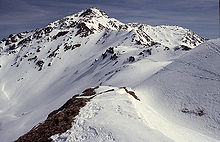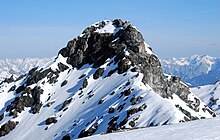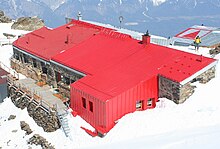Tux Alps
| Tux Alps | |
|---|---|
Tyrol | |
| Parent range | Central Eastern Alps |
The Tux Alps (
The
Neighbouring ranges
The Tux Alps are surrounded by the following other ranges in the Alps:
- Karwendel (to the north)
- Brandenberg Alps (to the northeast)
- Kitzbühel Alps (to the east)
- Zillertal Alps (to the south)
- Stubai Alps (to the west)

Boundary
To the north the
The Tuxer Joch saddle links the Tux Alps to the Zillertal Alps.
The Tux Alps are a popular ski touring and hiking area. Its ski resorts are Glungezer, Lizum im Wattental, Hochfügen-Hochzillertal, Penken and Kellerjoch, Patscherkofel. The Patscherkofel mountain was a venue for the 1964 and 1976 Winter Olympics held in nearby Innsbruck.
Major peaks
- Lizumer Reckner, 2,886 m
- Geier, 2,857 m
- Kalkwand, 2,826 m
- Rosenjoch, 2,796 m
- Rastkogel, 2,762 m
- Malgrübler, 2,749 m
- Hirzer, 2,725 m
- Glungezer, 2,677 m
- Gilfert, 2,506 m
- Grüblspitze, 2,395 m
- Kellerjoch, 2,344 m
- Patscherkofel, 2,246 m
Geology

The largest part of the Tux Alps comprises
Long-distance hiking trails
The long-distance hiking trail known as the "Munich to Venice Dream Path" (Traumpfad München-Venedig) runs through the Tux Alps. This is not an official long-distance trail. Nevertheless, the route, which was first proposed in 1977, has achieved a greater profile than many of the other trails officially established and maintained by states or rambling clubs.
The 9th day leg of the dream trail runs from Hall in Tirol up to the Glungezer Hut; the next stage over the seven tuxer summits and the Naviser Jöchl to the Lizumer Hut which is operated by the Austrian Alpine Club section at Hall.
The 10th and 11th days run from the Lizumer Hut to the Tuxer Joch Haus, then over the Pluderling Saddle and the Gschützspitze Saddle.
Other long-distance trails in the Tux Alps are the Eagle Way (Adlerweg), the Via Alpina (red), Olympic Way (Olympiaweg), Glungezer & Geier Way No. 335 (Glungezer&Geier-Weg 335), and Central Alpine Way No. 02a.
Huts

The following Alpine Club huts are located in the Tux Alps:
- Glungezer Hut
- Kellerjoch Hut
- Lizumer Hut
- Meißner Haus
- Navis Hut
- Patscherkofelhaus
- Rastkogel Hut
- Vinzenz Tolling Hut
- Voldertal Hut
- Weertal Hut
- Weiden Hut

